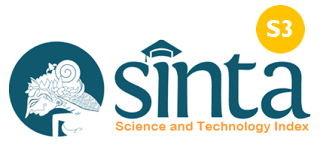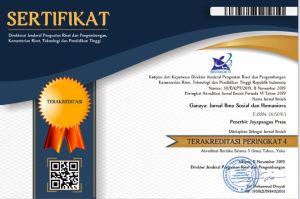Pendidikan dan Komunikasi Islam dalam Syair 'Aqaid Saeket KHR. Syamsul Arifin dan KHR. As'ad Syamsul Arifin
DOI:
https://doi.org/10.37329/cetta.v7i2.3208Keywords:
Islamic Education, Islamic Communication, Poetry of 'Aqaid SaeketAbstract
This research examines Islamic education and communication contained in the Syair 'Aqaid Saeket by KHR. Syamsul Arifin and KHR. As'ad Syamsul Arifin. This poem was written based on a lecture on the condition of the Madurese people, who are generally laypeople, who have very limited thinking and opportunities for in-depth study or reciting the Koran in Islamic boarding schools and are worried about the influx of deviant religious teachings. The educational method he uses is through the art of composing poetry as an innovative and alternative method. 'Aqaid Saeket is a Madurese term for the term 'Aqaid Khomsin ('Aqaid 50) which is a collection of qualities that are obligatory, muhal and jaiz for Allah SWT and His Messenger. The aim of this research is to reveal the message of Islamic education and communication in the Aqaid Poetry which can be used as an educational example for society. The method used in this research is a qualitative approach with descriptive analysis techniques with specifications for the type of library research (library study). This poem contains Islamic education in three categories, namely the values of faith, worship and morals. Aqidah education, includes belief in Allah with his impossible and improbable obligations, belief in the angels who were sent down, belief in the book, belief in the messengers with their impossible and impossible obligations, belief in the last day, belief in qadla' and qadar. Educational messages about worship, including prayer, zakat, fasting and Hajj. The message of moral education includes morals towards fellow creatures with advice to always be devoted to Allah SWT. The poetry of 'Aqaid Saeket contains five principles of Islamic communication, namely the principle of sincerity, the principle of reward and sin, the principle of positive speech, the principle of supervision, and the principle of mutual influence.
References
Adjie, P. (2004). Revolusi Nasyid. Bandung: MQS Publising.
Akhiruddin. (2015). Lembaga Pendidikan Islam di Nusantara. Jurnal Tarbiyah, 7(1), 195–219.
Ali. (1983). al Ta’rifat. Beirut; Dar al-Kuttub al-Ilmiyyah.
Amin, S. M. (2009). Ilmu Dakwah. Jakarta: Amzah.
Aminuddin. (1991). Pengantar Apresiasi Karya Sastra. Sinar Baru Algensindo, Bandung: Bina Cipta
Amrullah, F. (2019). Model Komunikasi Lembaga Pendidikan Islam. Jurnal Pendidikan Islam Indonesia (JPII), 3(2). 199-201
Ansori. (2016). Strategi Penanaman Nilai-Nilai Pendidikan Islam Pada Peserta Didik. Jurnal Pusaka. 8 (8), 14–32.
Arifin, M. (1993). Psikologi Dakwah Suatu Pengantar Studi. Jakarta: Bumi Aksara.
Astrid, S. (1997). Komunikasi dalam Teori dan Praktek. Bandung: Bina Cipta.
Asy’ari. (1999). Pengantar Studi Islam. Bandung: Pustaka Jaya.
Aziz. (2004). Ilmu Dakwah. Jakarta: Kencana.
Backtiar, W. (1997). Metodologi Penelitian Ilmu Dakwah. Jakarta: Logos Wacana Ilmu.
Banasuru, A. (2014). Filsafat dan Filsafat Ilmu dari Hakikat ke Tanggung Jawab. Bandung: Alfabeta.
Cangara, H. (1998). Pengertian Ilmu Komunikasi. Jakarta: Raja Grafindo Persada.
Dasuki, H. (2017). Al-qur'an dan Terjemahannya. Bandung: Gema Risalah Press.
Effendi, O. U. (2003). Ilmu Komunikasi Teori dan Praktek. Bandung: Remaja Rosdakarya.
Esa, P. A. (2004). Revolusi Nasyid. Bandung: MQS Publising.
Hannan. (1975). Zuhud Ighatsat al-Lahfan, Beirut: Dar al-Ma;rifah.
Hefni, H. (2017). Komunikasi Islam. Jakarta : Prenamedia Grup.
Ilahi, W. (2010). Komunikasi Dakwah. Bandung: PT Remaja Rosdakarya.
Ilyas, F. (2022). Syair Aqaid Saeket sebagai Media Dakwah Kultural Kiai As’ad Syamsul Arifin. Jurnal al Hikmah. 16(1), 69
Joseph. (1991). Human Communication The Basic Course. New York: Harper Collins Publishers.
Jumantoro, T. (2019). Psikologi Dakwah. Jawa Barat: Sinar Grafika Offset.
Khotib, M. (2018). Syarah ‘Aqaid Saeket, Situbondo : Tanwirul Afkar.
Mawaddah, N. (2021). Syair Aqaid Saeket Sebagai Metode Dakwah Dalam Menanamkan Aqidah Ahlussunnah Wal Jamaah Annahdliyah. Jurnal Lisan al Hal. 15(1), 137
Muhammad, S. (2004). Dakwah Fardiyah “Pendekatan Personal Dalam Dakwah. Solo: Era Intermedia.
Muhiddin. (2002). Dakwah dalam Prespektif Al-Qur’an: Studi Kritis atas Visi, Misi dan Wawasan. Bandung: Pustaka Setia.
Mulyana, D. (2015). Pengantar Ilmu Komunikasi. Bandung: PT Remaja Roesdakarya.
Nawawi, I. (2007). Nur adh-Dhalam. Jakarta: Darul Fikr.
Nuh, M. (2004). Dakwah Fardiyah Pendekatan Personal Dalam Dakwah. Solo:Era Intermedia.
Purwadarminta, W. (2005). Kamus Besar Bahasa Indonesia. Jakarta : Balai Pustaka.
Rahman, A. (2012). Pendidikan Agama Islam dan Pendidikan Islam - Tinjauan Epistemologi Dan Isi - Materi. Jurnal Eksis-Riset, 8(1), 2053–2059.
Rakhmat, J. (1982). Retorika Modern: Sebuah Kerangka Teori dan Praktek Berpidato. Bandung: Akademia.
Ropingi. (2016). Pengantar Ilmu Dakwah. Malang: Madani.
Rosidah. (2015). Definisi Dakwah Islamiyyah Ditinjau Dari Perspektif Konsep Komunikasi. Jurnal Qathruna. 2(2), 234-238
Tasmoro, T. (1997). Komunikasi Dakwah. Jakarta: Gaya Media Pratama.
Taufiq, I. (2018). Syarah ‘Aqaid Saeket. Situbondo: Tanwirul Afkar.
Tubbs, S. (2001). Human Communication. Bandung; PT. Remaja Rosdakarya.
Yaacob, O. (2007). Dunia pendidikan dalam era Globalisasi : Peranan dan Cabaran. Jurnal Pendidikan, 30(1), 143–148.
Downloads
Published
How to Cite
Issue
Section
License
Copyright (c) 2024 Moch. Nuril Anwar, Sofyan Hadi, Sukarno Sukarno

This work is licensed under a Creative Commons Attribution-ShareAlike 4.0 International License.
An author who publishes in the Cetta : Jurnal Ilmu Pendidikan agrees to the following terms:
- Author retains the copyright and grants the journal the right of first publication of the work simultaneously licensed under the Creative Commons Attribution-ShareAlike 4.0 License that allows others to share the work with an acknowledgement of the work's authorship and initial publication in this journal
- Author is able to enter into separate, additional contractual arrangements for the non-exclusive distribution of the journal's published version of the work (e.g., post it to an institutional repository or publish it in a book) with the acknowledgement of its initial publication in this journal.
- Author is permitted and encouraged to post his/her work online (e.g., in institutional repositories or on their website) prior to and during the submission process, as it can lead to productive exchanges, as well as earlier and greater citation of the published work (See The Effect of Open Access).
Read more about the Creative Commons Attribution-ShareAlike 4.0 Licence here: https://creativecommons.org/licenses/by-sa/4.0/.





